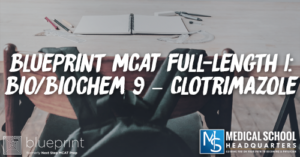You still have time to sign up with one of our amazing expert advisors! Learn More!

We’re on Bio/Biochem passage 9 from Blueprint MCAT full-length 1. Join me and Alex as we break down this passage about glycolysis, bioenergetics, and cancer.
We’re joined by Armin from Blueprint MCAT. If you would like to follow along on YouTube, go to premed.tv.
Listen to this podcast episode with the player above, or keep reading for the highlights and takeaway points.
A major challenge facing cancer research is how to create therapies that specifically target and kill cancerous cells with minimal effects on non-malignant cells. One of the most promising avenues is the targeting of cancer cells’ metabolic profile. Cancerous cells have much higher glycolytic flux (rate of glycolysis) than normal cells due in part to their rapid growth and cell division. Malignant cells rely more on fermentation than normal cells. Thus, compounds that interfere with key glycolytic enzymes may selectively induce apoptosis in cancer cells. One example of such a compound is clotrimazole (CTZ), which is shown in Figure 1.
Figure 1 Structure of CTZ
Notes:
We all know chemotherapy is really bad because it kills lots of healthy cells as well as the cancer cells. And so how do we fix that? We’re also highlighting the key phrases in bold, which we recommend students should highlight.
And Figure 1 shows a structure of CTZ. Looking at this molecule immediately, it’s got a lot of aromatic rings. This is almost certainly a very nonpolar structure. It’s very hydrophobic and there aren’t a lot of polar bonds there.
CTZ interferes with glycolysis, specifically with the enzymes hexokinase (HK), phosphofructokinase (PFK), and aldolase (ALD). This causes cell cycle arrest in G1 and leads to apoptosis. However, the structure of CTZ limits its tissue delivery, which restricts therapeutic use of CTZ. To circumvent this problem, researchers created nano-micelles embedded with CTZ. The efficacy of the nano-encapsulated version of CTZ (nCTZ) was compared to that of unencapsulated CTZ (uCTZ) for treating human breast cancer cell line MCF-7. In vitro, MCF-7 cell populations were treated with identical concentrations (50 μM) of nCTZ and uCTZ for 24 hours. PFK and HK activity were assayed before and after treatment to measure glycolytic ability. Cytosolic ATP concentrations were also measured. The results are shown in Table 1. Enzyme activity is expressed as a value normalized to the baseline levels present without the encapsulation.
Table 1 Results of experiment comparing nCTZ and uCTZ
Notes:
This experimental design to try and solve the problem is a classic kind of research paper writing. So we’ve got this amazing molecule, but its structure limits us giving it to cells. How are we going to fix that? What’s their research? So they’ve put them in these nano-micelles embedded with CTZ. Then they’re comparing these nano-encapsulated versions of CTZ (nCTZ) with unencapsulated CTZ (uCTZ). And they’re testing it on a human breast cancer cell line called MCF-7.
Then they measured these enzyme activities. The design itself is relatively straightforward, but we just have to be very clear on what they’re measuring. Which is PFK and HK activity and ATP concentration, and how it’s being expressed as a value normalized to baseline levels. Presumably, we’ll get relative to 1, probably less given that we’re dealing with an inhibitor.
What this table is telling us is that nano-encapsulated CTZ treatment works. The encapsulation gets it into the cells, which is the issue with CTZ. And nCTZ and uCTZ probably have about the same effect on PFK. But uCTZ probably has almost no effect on HK. And only the nCTZ reduces cytosolic ATP to any reasonable degree. Therefore, CTZ is probably a better cancer treatment.
Positron Emission Tomography (PET) scans follow the movement of a radioactively labeled compound throughout the body and are often used to detect metabolic activity in cancer cells relative to normal cells. The labeled compound is most likely:
Thought Process:
This is a pseudo discrete question. This question just wants to talk about how PET scans work. We’re looking at a radioactively labeled compound. So we have to put a compound into the body. It tells us that it’s detecting metabolic activity. And so we know from the passage, there’s a little bit of passage inflammation that cancer cells are more metabolically active – higher glycolytic flux (rate of glycolysis. And so it would tell us that glucose would be the label because these cells are going to be taking up glucose and doing stuff with it.
Looking through the other answer choices:
A – Pyruvate is generated from the breakdown of glucose in glycolysis. But that doesn’t circulate in the body to any meaningful extent. It is transported through the body, but does that as its intermediate lactic acid and the Cori cycle.
B – acetyl-CoA is fed into the Krebs cycle, but again, it’s almost entirely produced and consumed intracellularly.
C – Your cells don’t pick up ATP from the blood. They produce it themselves from the glucose that they pick up from the blood.
Correct Answer: D
Which of the following most accurately summarizes the efficacy of nCTZ vs uCTZ against MCF-7 in vitro?
Thought Process:
As what we’ve summarized earlier in the table, that nCTZ is more effective than uCTZ as it reduces cytosolic [ATP] because it’s killing the cells. It’s not making ATP anymore. And D is the one that answers that the same way that we answered it.
What output are we interested in terms of efficacy against cancer cells? It’s not PFK and HK, but it’s actually ATP concentration. If the cancer cell doesn’t have any ATP, then it’s going to die.
Correct Answer: D
According to the passage, which feature of CTZ presents the most significant obstacle to its use as a cancer drug?
Thought Process:
Those rings of carbons and hydrogens have delocalized electrons that kind of swim all around them. But ultimately, they’re made up of nonpolar bonds, they all share their locked electrons pretty evenly. It’s so even that the electrons aren’t tied to any particular atom. They swim around the ring, which is what makes these kinds of structures so stable.
Many students are tempted to answer C or D because both are true. But you have to answer the question. And the question is asking us, what’s the obstacle?
What property do those two things together lend to the molecule making it a barrier? And in this case, it’s the solubility behavior. This is the hydrophobic molecule, which means that it’s not going to be able to dissolve very well in the hydrophilic media.
For it to get into cells, it needs to dissolve in your blood, and it needs to dissolve in the cytosol of your cells. Both of those liquids are almost entirely water, which is a hydrophilic medium. So the right answer here is A.
Correct Answer: A
If necessary to design a new experiment, which of the following best explains why researchers could use measurements of intracellular lactate levels (ILL) in cancer cells to assess efficacy of cancer drugs?
Thought Process:
We would assume that lactate levels would be high in cancer cells because it’s relying on fermentation. And if a cancer drug would work on that cell, then those lactate levels should drop. So we want low intracellular lactate levels. And so that gets rid of answer choice A and C right off the bat.
So now we’re 50/50. It’s so easy to narrow it down to the last two and then get stuck, get scared, and start overthinking it.
This passage is about glycolysis so D would probably be irrelevant. Now, if there are some nuggets of content that you’re missing, then it might be D. But in this case, B is the right answer.
The pentose phosphate pathway, also known as the pentose phosphate shunt, is a kind of separate pathway that diverts some six-carbon sugars away from general metabolism in your cells. They are converted into pentose sugars to make nucleotides and regenerate NADPH, which is a really important biosynthetic molecule.
Correct Answer: B
According to the experimental results, which enzyme is most sensitive to inhibition by CTZ?
Thought Process:
A & B – Glucose is not an enzyme so we can get rid of these two right off the bat.
C – PFK was inhibited by both the nCTZ and uCTZ.
D – HK was only affected by the nCTZ.
So PFK is the most sensitive because it was inhibited by both the nCTZ and uCTZ.
Correct Answer: C

Lorem ipsum dolor sit amet, consectetur adipiscing elit
I just received my admission to XXXXX! This is unreal and almost feels like I am dreaming. I want to thank you for all of your help with my application. I cannot overstate how influential your guidance and insight have been with this result and I am eternally grateful for your support!
IM SO HAPPY!!!! THANK YOU SO MUCH FOR ALL YOUR HELP, IM INDEBTED TO YOU! Truly, thank you so much for all your help. Thank you doesnt do enough.
I want to take a few moments and thank you for all of your very instructive, kind and consistent feedback and support through my applications and it is your wishes, feedback, and most importantly your blessings that have landed me the acceptance!
I got into XXXXX this morning!!!! It still has not hit me that I will be a doctor now!! Thank you for all your help, your words and motivation have brought me to this point.
I wanted to once again express my heartfelt gratitude for your help in providing feedback during my secondary applications. Your guidance has been instrumental in my journey.
Just wanted to share my wonderful news! I received my first medical school acceptance! Thank you for all that you do for us Application Academy!!!
I am excited to tell you that I just got my third interview invite from XXXXX today! I can’t believe it. I didn’t even know if I was good enough to get one, let alone three – by mid-September. Thank you so much for all of your help and support up to this point; I would not be in this position without it!!
I wanted to thank you for helping me prepare for my XXXXX interview. Even in a 30-minute advising session, I learned so much from you. Thank you for believing in me, and here’s to another potential success story from one of your advisees!
I just received an acceptance with XXXXX! This is so exciting and such a huge relief and so nice to have one of our top choice schools! I also received an interview with XXXXX which brings the total up to 20 interviews! Thank so much, none of this would have been possible without you!

Join our newsletter to stay up to date
* By subscribing you agree to with our Privacy Policy and provide consent to receive updates from our company.
Resources
Advising Services
Podcasts & Youtube
Books
About
Deal Lasts for

"*" indicates required fields